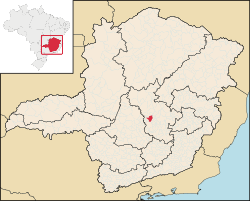
Belo Horizonte is the sixth-largest city in Brazil, with a population of around 2.3 million, and the third largest metropolitan area, with a population of 6 million. It is the 13th-largest city in South America and the 18th-largest in the Americas. The metropolis is anchor to the Belo Horizonte metropolitan area, ranked as the third most populous metropolitan area in Brazil and the 17th most populous in the Americas. Belo Horizonte is the capital of the state of Minas Gerais, Brazil's second-most populous state. It is the first planned modern city in Brazil.
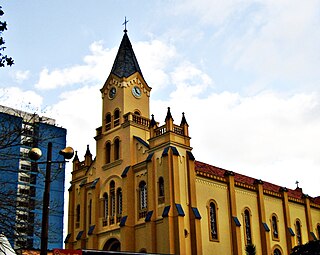
Manhuaçu is a municipality in Eastern Minas Gerais state, in Brazil. Its population was 91,169 (2020) and its area is 628 km2.

Montes Claros is a city located in northern Minas Gerais state, in Brazil. It is located north of the state capital, about 422 km away from it. The population is 413,487 in an area of 3,569 km2 (1,378 sq mi). It was made a seat of a municipality in 1831 and attained city status in 1857.
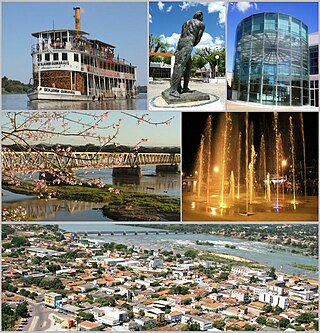
Pirapora is a municipality in northcentral Minas Gerais in Brazil. The population is 56,640 in an area of 550 km². The name Pirapora comes from the Tupi words for "fish" + "jump", referring to the piracema season when a mass migration of fishes ascends the São Francisco River to spawn.
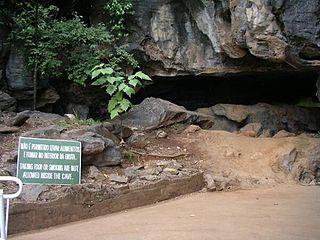
The Gruta Rei do Mato (MG-3653) is a cave located at the edge of the BR-040 highway, close to the off ramp to the city of Sete Lagoas, in Minas Gerais, Brazil. From Sete Lagoas the cave can easily be reached by bus, taxi or car. Sete Lagoas is 70 km (43.5 mi) from Belo Horizonte, the capital of the state.
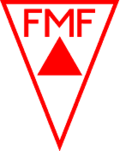
Campeonato Mineiro is the Brazilian state football league of the state of Minas Gerais and is controlled by the Federação Mineira de Futebol (FMF).

Estádio Raimundo Sampaio, more commonly known as Independência, is a football stadium located in the Horto neighborhood of Belo Horizonte, Minas Gerais, Brazil. It was built in 1950 for the FIFA World Cup, held in Brazil. Initially its capacity was 30,000 people, but after the reconstruction between 2010 and 2012, the capacity is approximately 23,000 people. It belonged to the defunct Sete de Setembro Futebol Clube, which is why the stadium is called Independence. The stadium is currently property of América Futebol Clube, but has been leased to the Minas Gerais state government for 20 years, as a counterpart to the injection of public resources to demolish the old stadium and build the new one.

Curvelo is a municipality in the state of Minas Gerais, Brazil. It is located in the geodesic centre of Minas Gerais, 170 km north of the capital, Belo Horizonte, and connected to the capital by highways MG 135 and BR 040. Its estimated population is 80,616 inhabitants (2020) and the total area of the municipality is 3,344 kmª. The city lies at an altitude of 633 metres.
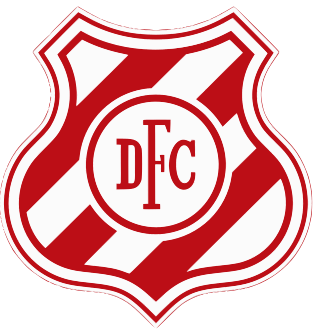
Democrata Futebol Clube, also referred to as Democrata de Sete Lagoas, Democrata-SL or just Democrata, is a Brazilian association football team from the city of Sete Lagoas in Minas Gerais state.

Araçaí is a Brazilian municipality located in the northeast of the state of Minas Gerais. Its population as of 2020 was 2,354 people living in a total area of 185 km². The city belongs to the meso-region of Metropolitana de Belo Horizonte and to the micro-region of Sete Lagoas. It became a municipality in year of 1962.

Felixlândia is a Brazilian municipality located in the northeast of the state of Minas Gerais. Its population as of 2020 was 15,433 living in a total area of 1,553 square kilometres (600 sq mi). The city belongs to the statistical mesoregion of Central Mineira and to the statistical microregion of Curvelo. It became a municipality in 1948.

The Roman Catholic Archdiocese of Belo Horizonte is an archdiocese located in the city of Belo Horizonte in Brazil.

Paraopeba is a Brazilian municipality located in the northeast of the state of Minas Gerais. Its population as of 2020 was 24,700 people living in a total area of 625 square kilometres (241 sq mi). The city belongs to the meso-region of Metropolitana de Belo Horizonte and to the micro-region of Sete Lagoas. It became a municipality in 1911.

Caetanópolis is a Brazilian municipality located in the northeast of the state of Minas Gerais. Its population as of 2020 was 11,749 people living in a total area of 156 km². The city belongs to the meso-region of Metropolitana de Belo Horizonte and to the micro-region of Sete Lagoas. It became a municipality in 1954.
The Estádio Joaquim Henrique Nogueira, or Nogueirão, also nicknamed Arena do Jacaré, is a football stadium located in Sete Lagoas, Minas Gerais state, it seats 20,020 people. The stadium's official name comes from a farmer from a traditional family of the region who gave the land which the stadium was built on, while the nickname comes from the mascot of local team Democrata Futebol Clube, a Caiman.

BR-040 is a federal highway of Brazil. The 1,139.3 kilometres (707.9 mi) road connects Brasilia to Rio de Janeiro.

Greater Belo Horizonte, Brazil, is the name usually used to describe the Belo Horizonte metropolitan region, which is composed of 34 municipalities. As of 2013, it is the third largest metropolitan area of Brazil with more than Six million inhabitants; the largest city by population is Belo Horizonte.
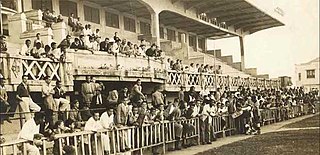
The Estádio Presidente Antônio Carlos, commonly known as Estádio de Lourdes and colloquially as Estadinho da Colina was a stadium located in Belo Horizonte, Brazil, owned by Atlético Mineiro. The ground, opened in the Lourdes neighborhood on 30 May 1929, had an estimated capacity of 5,000 and was Atlético's home until 1950. It remained largely unused by the first squad until its demolition in 1994, when a shopping mall was built on the site.
The Immediate Geographic Region of Sete Lagoas is one of the 10 immediate geographic regions within the Intermediate Geographic Region of Belo Horizonte. It is also among the 70 immediate geographic regions found in the state of Minas Gerais, Brazil. Furthermore, it is one of the 509 immediate geographic regions established by the National Institute of Geography and Statistics (IBGE) in 2017.
The 2023 Campeonato Mineiro is the 109th edition of the state championship of Minas Gerais organized by the FMF. The competition started on 21 January and ended on 9 April 2023.

